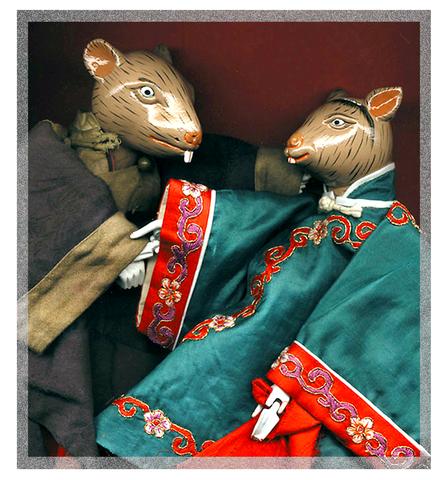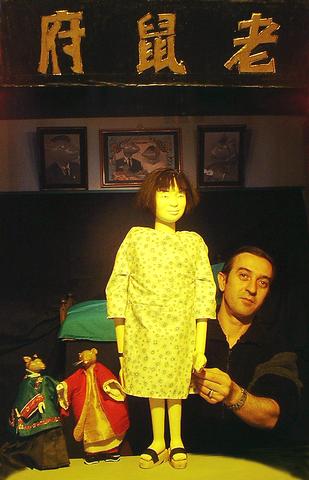Puppetry is one of Taiwan's most important folk arts, and even now that its heyday has passed, it continues to exercise a powerful influence on local culture. In order to bring it into the modern world, puppeteers have sought to incorporate all kinds of new elements, some more successfully than others. Probably some of the boldest experiments, albeit on a small scale, are being conducted by the TTT Puppet Centre in Taipei. They are introducing a new show, The Wedding of the Mice
The Wedding of the Mice is based on a traditional Chinese New Year fable but has been extensively reworked to give it a stronger appeal to a modern audience. "We don't want it to be something like a legend, which is distant [from the audience]," said Wu Shan-shan

The story begins with an old lady remembering a wonderful experience of her childhood. When she was little girl, she accidentally entered the Mouse Mansion. She overheard that two young mice lovers were going to be separated. The young mouse girl is the daughter of the lord of the Mouse Mansion and she is deeply in love with the young and poor inventor A-lang. The young girl is sympathetic to their plight and figures out cunning ways to help the lovers be together, convincing the father of the girl that A-lang should be her husband. The play ends with the wedding festival of the mice, which traditionally takes place on the third day of the Chinese New Year. On this day, all Chinese children have to be quiet all night because the mice are having a wedding.

PHOTO COURTESY OF TTT
"We introduced the character of the little girl to give the story something to which children could relate to in their own experience," Wu said. The performance adopts a storytelling format, with Wu telling the story as the action takes place on stage. This follows on from a tradition in which the human performers interact with the puppets on a stage that was used in the puppet center's previous show, Marco Polo. This earlier show, which met with considerable success and has been invited to perform by the Obraztsov Central State Academic Theater in Russia and will also play at the Festival Internationale Del Teatro Per Ragazzi in Porto S. Elpidio in Italy, combines nankuan areas and Italian opera to tell a story of Marco Polo's adventures in China.
While there is less of an Italian flavor in The Wedding of the Mice -- it is a Chinese New Year puppet show after all -- the cultural mix is equally innovative. For the mice characters, traditional Taiwanese glove puppets are used, but the little girl is a much larger rod puppet which is manipulated by Italian puppeteer Massimo Godoli Peli, who also worked on Marco Polo. There are also three Mafia mice in the current show created by Peli, who favors the most traditional materials, making the puppets from a mixture of rag, glue, flour, eggs and vinegar.
While The Wedding of the Mice crosses many cultural boundaries, both Peli and Robin Ruizendaal, the show's director, emphasize the need to work from tradition. "Of course we follow tradition, but we are also constantly developing something else. Otherwise you are just specializing in one thing, doing the same thing for 20 years; it is no different from working in a bank," Peli said. He is currently working on a new show in which he brings two Italian stock comic characters to Taipei, where they proceed to make all kinds of rumpus.
While this project aims for the raucous violence and crude humor of a Punch and Judy show -- with echoes of Ah Chung Puppet Theater, who created puppetry in a contemporary Taiwanese vernacular -- The Wedding of the Mice goes for the lyrical touch very suitable to the intimate space of the TTT Puppet Centre where it will be performed.
According to Bart Roccoberton Jr, a professor of puppet arts at the University of Connecticut, puppets actually feature heavily in modern advertising and stage performance, and in some respects, the high status given to puppetry as an "art form" can get in way of its acceptance by a wider public. By bringing together a number of diverse traditions, hoary old authenticity is put aside and the freshness and creativity of various art forms can be more readily expressed.

April 28 to May 4 During the Japanese colonial era, a city’s “first” high school typically served Japanese students, while Taiwanese attended the “second” high school. Only in Taichung was this reversed. That’s because when Taichung First High School opened its doors on May 1, 1915 to serve Taiwanese students who were previously barred from secondary education, it was the only high school in town. Former principal Hideo Azukisawa threatened to quit when the government in 1922 attempted to transfer the “first” designation to a new local high school for Japanese students, leading to this unusual situation. Prior to the Taichung First

Chinese Nationalist Party (KMT) Chairman Eric Chu (朱立倫) hatched a bold plan to charge forward and seize the initiative when he held a protest in front of the Taipei City Prosecutors’ Office. Though risky, because illegal, its success would help tackle at least six problems facing both himself and the KMT. What he did not see coming was Taipei Mayor Chiang Wan-an (將萬安) tripping him up out of the gate. In spite of Chu being the most consequential and successful KMT chairman since the early 2010s — arguably saving the party from financial ruin and restoring its electoral viability —

The Ministry of Education last month proposed a nationwide ban on mobile devices in schools, aiming to curb concerns over student phone addiction. Under the revised regulation, which will take effect in August, teachers and schools will be required to collect mobile devices — including phones, laptops and wearables devices — for safekeeping during school hours, unless they are being used for educational purposes. For Chang Fong-ching (張鳳琴), the ban will have a positive impact. “It’s a good move,” says the professor in the department of

Article 2 of the Additional Articles of the Constitution of the Republic of China (中華民國憲法增修條文) stipulates that upon a vote of no confidence in the premier, the president can dissolve the legislature within 10 days. If the legislature is dissolved, a new legislative election must be held within 60 days, and the legislators’ terms will then be reckoned from that election. Two weeks ago Taipei Mayor Chiang Wan-an (蔣萬安) of the Chinese Nationalist Party (KMT) proposed that the legislature hold a vote of no confidence in the premier and dare the president to dissolve the legislature. The legislature is currently controlled